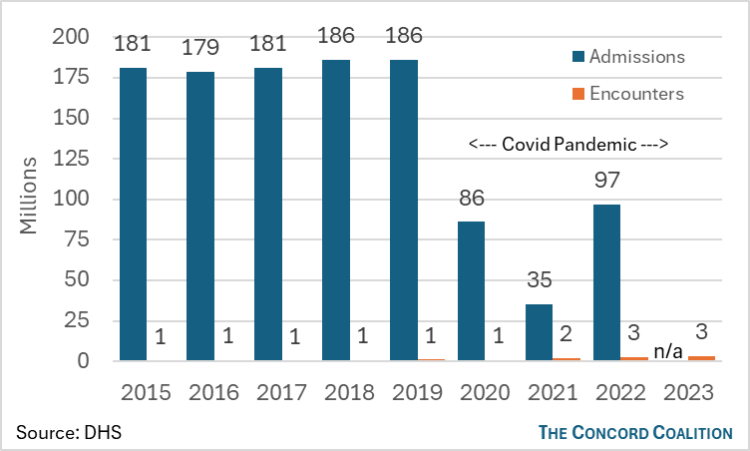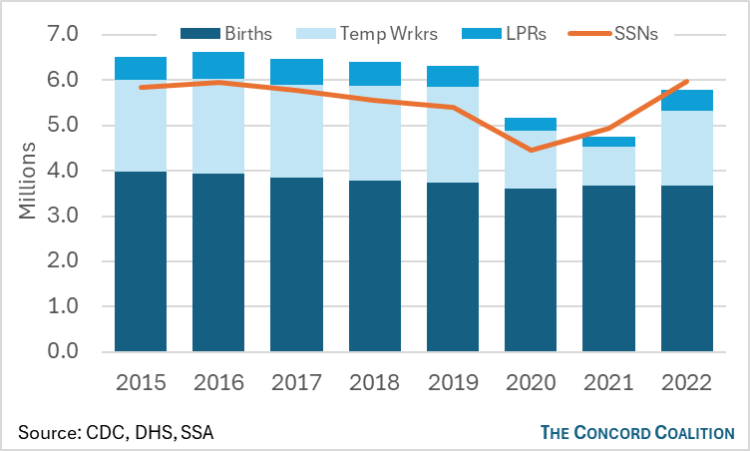During the recent presidential debate, former president Donald Trump said the Biden Administration was destroying Social Security and Medicare by allowing millions of people to pour into our country and collect benefits. It’s true millions of people pour into the United States every year. But most of them are just visiting and then they go home. They don’t work, they don’t pay taxes, and they don’t collect benefits. Among those who do pay into these programs, many are unlikely to ever receive benefits because they are not lawfully present in the United States or they did not contribute long enough to qualify.
According to the U.S. Department of Homeland Security (DHS), there were 97 million “admissions” of foreign nationals in 2022. Admissions include tourists as well as temporary visa holders who are authorized to work in the United States. Admissions exclude lawful permanent residents even though they are foreign nationals. Individuals crossing the border illegally, which DHS defines as “encounters” when these individuals are apprehended, are not included. Neither admissions nor encounters are unduplicated counts. Individuals who enter, leave, and re-enter multiple times are counted multiple times, although not for multiple entries on the same day.
The figure below shows the number of admissions (blue bars) and encounters (orange bars) from 2015 to 2023. Although admissions have rebounded somewhat from their low-point during the Covid pandemic (from 35 million to 97 million), encounters are up significantly (from 1 million to 3 million).

The impact of immigration on Social Security and Medicare does not depend on the number of people crossing our border, but rather on the age, earnings, family composition, and legal status of those who work, pay taxes, and collect benefits – or not. Illegal workers and temporary visa holders who pay taxes, but never collect benefits, provide a financial boost to these programs. Older immigrants who earn the minimum necessary to qualify for benefits likely collect more than they contribute. Younger immigrants offset our declining birth rates and increase the ratio of workers-to-beneficiaries. But only an implausibly large and rising level of immigration would significantly improve the long-term financial outlook of Social Security and Medicare.
Individuals who are not authorized to work often obtain employment using fake IDs and phony Social Security numbers (SSNs). Because they do not have a valid SSN, when their employer files taxes with the IRS, their wages are posted to the earnings suspense file (ESF) maintained by the Social Security Administration (SSA). The ESF records the wages of workers who do not match SSA’s records. According to SSA, the ESF increased by $140 billion in 2022. These wages account for $21 billion in payroll taxes. Thus, unauthorized workers pay for benefits they will never receive, unless they eventually obtain legal authorization to work in the United States.
Individuals who are authorized to work – because they obtain a temporary visa or lawful permanent resident (LPR) status – may pay taxes and receive benefits depending on their circumstances.
When considering the impact of immigration on Social Security and Medicare, it’s important to remember these programs include a work requirement. Individuals must work at least 40 quarters (10 years) in covered employment – and pay taxes on their wages – to qualify for retirement benefits, or pay an additional monthly premium for Medicare.
Individuals who are authorized to work, but subsequently lose their legal status – e.g. temporary visa expires – cannot receive benefits in the United States and can only receive benefits outside the United States for six months, unless they live in a country that pays benefits to U.S. citizens living outside that country. There were 700,000 Social Security beneficiaries living outside the United States in 2022. That number includes both U.S. citizens and non-U.S. citizens living abroad.
The number of individuals obtaining a Social Security number (SSN) each year can be used as a proxy to estimate the potential number of workers authorized to work and contribute to Social Security and Medicare. However, absent longitudinal data on the number of temporary workers who renew their visas or obtain LPR status, it’s impossible to know how many will ultimately collect benefits.
Approximately six million SSNs are issued each year. Most SSNs are issued to children born in the United States under SSA’s enumeration at birth program. The remaining SSNs are issued to noncitizens who typically obtain authorization to work.
The figure below shows the number of SSNs issued from 2015 to 2022 and the corresponding number of U.S. births, admissions of temporary visa holders (workers and trainees), and individuals obtaining (LPR) status that have newly arrived in the United States. These numbers do not align exactly because they include multiple entries by the same individuals, and some visa categories are excluded from Social Security and Medicare coverage.

Measuring the impact of immigration on Social Security and Medicare is admittedly difficult. The results will vary based on the individual characteristics of each immigrant and the long-term trends in total immigration. The available evidence suggests the net effect is more likely positive than negative, but in either case, immigration will neither save these programs nor precipitate their demise. Policymakers must look beyond the border to address the financial problems facing these programs.




